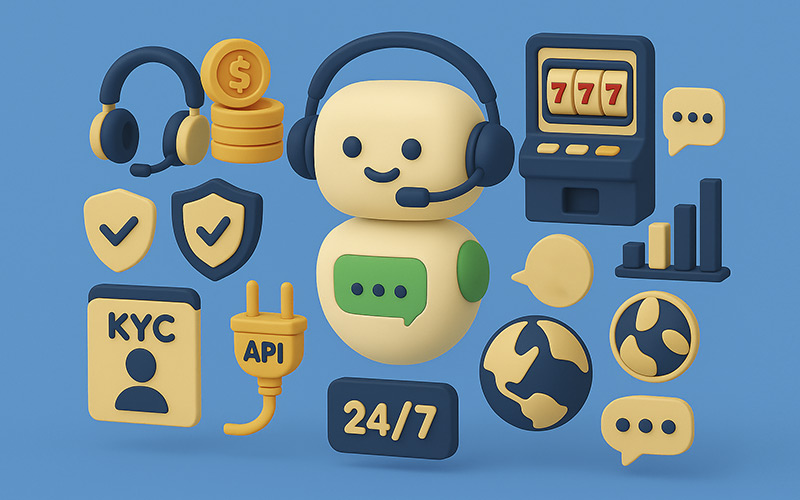What Automation and AI Actually Deliver in iGaming
Every team claims to be using the same trendy tech these days. Artificial intelligence. Automation. Transformation. In reality, barely anything around the product or the team actually feels different. People still paste numbers from emails into spreadsheets, answer the same questions again, and sit over tests that a script could run in a few seconds.
The gap is not a lack of tools, but a missing habit of identifying and automating tiny, predictable tasks, thereby turning them into simple, reliable workflows. Change rarely begins with a large platform update or a sweeping rebuild. It starts with a single trigger and a clear action that quietly saves an hour today and every day after.

For iGaming companies, this mindset matters. Margins depend on speed, quality, and clean hand-offs between functions. When routine work moves on its own, teams recover time for ideas, analysis, and the kind of fixes that move KPIs rather than create more busywork.
Gaminator experts are here to tell you about automation and AI as a set of small levers hidden in daily operations. If applied correctly, the result is fewer errors, faster responses, and a stack that works as a single unit.
Measurable Outcomes of AI
It is easy to talk about artificial intelligence. However, the real value emerges when automation eliminates manual work, enhances service, and preserves margins. The target is shorter cycles, fewer errors, and cleaner hand-offs across the stack.
Where automation and AI pay off most:
- Product testing and compliance. Daily checks surface defects early and keep technical standards intact.
- Customer support. Assistants draft replies, route tickets, and summarise threads for faster resolution.
- Sales and marketing. Lead capture, scoring, and campaign ops run on rules instead of memory.
- Data analysis. Pipelines collect, clean, and push numbers to dashboards without the need for copy-paste.
- HR and recruitment. Screening, scheduling, and status updates are triggered to move forward.
Real impact depends on fit. Tools must align with the process, share data, and support clear ownership. When outcomes are measured and flows connected, the “AI-driven” label becomes time saved and revenue retained.
Practical Path to Proper Implementation
Big programs look impressive, yet the safest progress often starts small. A careful sequence reduces risk, proves the case, and builds trust inside the team. Treat early automation as a series of controlled experiments that free time and show clear numbers.
A simple sequence to follow:
- Spot the loops. List tasks that repeat on a daily or weekly rhythm and adhere to the same steps every time.
- Trim the workflow. Remove detours and duplicate approvals before scripting anything; otherwise, you will create clutter.
- Choose for function, not fashion. If a lightweight setup in Make, Zapier, or n8n meets your needs, use it.
- Run a small trial. Automate one slice of the process for one team and one data source to confirm value and edge cases.
- Measure and adjust. Track time saved, error rates, and cycle time, then fix field mappings, thresholds, and rules as reality changes.
- Verify AI outputs daily. Treat models as assistants, review samples, watch for drift after updates, and keep a rollback path.
- Link the islands. Once several automations are working, connect them so that data moves end to end without manual handoffs.
Further Ecosystem Configuration
Tools are most effective when the path is clear and the data moves smoothly without friction. Many teams collect apps faster than the outcomes, and the result is noise. A steady ecosystem turns scattered utilities into a working system.
How to shape the framework:
Process First
Automation magnifies the shape of the workflow beneath it. If the path is tangled, scripts only push the mess faster. Map the journey from trigger to outcome, remove outdated steps, and agree on a single approach to doing things. A clean path turns small scripts into steady gains.
Data Flows
Tools must pass information without human relays. Define owners for each system, pick a source of truth, and standardise fields and formats. When hand-offs are explicit and naming is consistent, data travels safely and dashboards stay trustworthy.
Governance and Iteration
Good automation lives under light rules. Set simple KPIs, log every run, and review failures on a regular cadence. Retire flows that no longer pay off, and improve ones that do. Small upkeep keeps the stack healthy and the results reliable.
The iGaming Toolbox

Practical instruments turn plans into visible progress. The right picks remove guesswork, cut delays, and protect revenue. Each option below targets a real bottleneck to focus on and maximise performance.
Focused solutions operators can deploy quickly:
PlayPatrol
This automated game-testing system runs daily AI checks across large slot catalogues and flags anomalies before players notice. Image recognition and batch runs reveal broken flows, visual glitches, or integration slips across multiple platforms in one sweep. Early visibility keeps incidents small, protects income, and supports technical compliance.
WinWords AI
This content and SEO tool drafts unique long-form pieces from external sources and shapes them according to optimisation rules. Headlines, meta fields, and internal links are prepared for publishing, while WordPress pushes articles live. Content teams move from manual assembly to editorial review and prioritise topics that matter.
PageZen
The performance-watch software tracks speed, uptime, and error spikes around the clock. When load times drift or pages fail, alerts reach the team with enough context to act fast. Faster pages enhance user comfort, and stable performance supports conversions during busy periods and campaigns.
PlayUp
The UX and retention lens reviews the product from a player’s point of view, to cover support touchpoints, accessibility, and journey friction. Findings translate into precise fixes that lower churn and make navigation intuitive. The result is a cleaner path to gameplay and more sessions per user.
The Main Things about Automation and AI in iGaming
Modern stacks do not need grand rebuilds to show results. Small, targeted automations compound into faster cycles, cleaner data, and steadier revenue.
Key takeaways to keep in mind:
- Start small and prove value with one well-chosen flow before expanding.
- Streamline the workflow first, then script it to avoid scaling disorder.
- Select tools based on outcomes and measure the time saved and errors reduced.
- Treat AI as an assistant that needs daily checks, logging, and safe rollbacks.
- Connect successful automations, so data moves end-to-end without manual relays.
Check the information used to contact us carefully. It is necessary for your safety.
Fraudsters can use contacts that look like ours to scam customers. Therefore, we ask you to enter only the addresses that are indicated on our official website.
Be careful! Our team is not responsible for the activities of persons using similar contact details.



